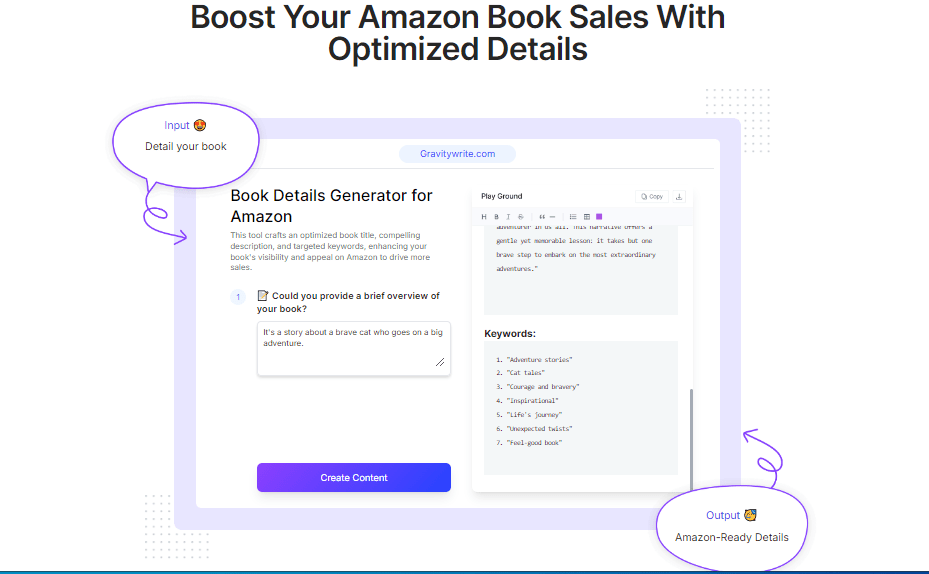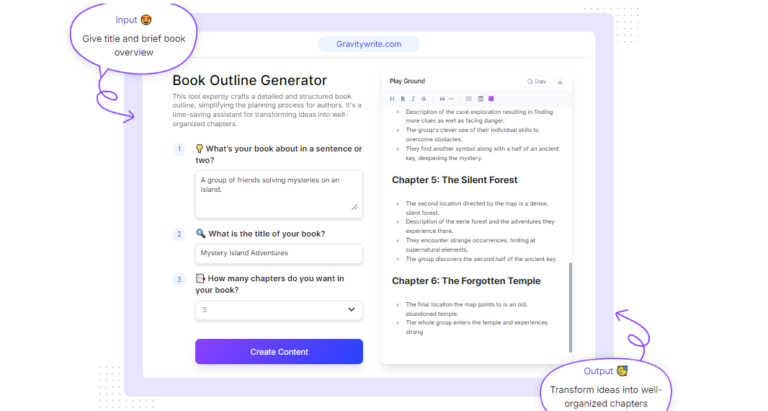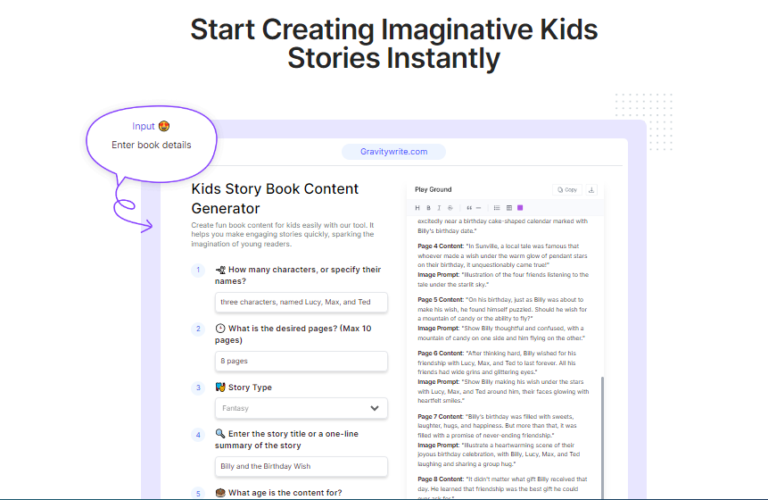Comprehensive guide on writing a children’s book, covering essential steps, tips, and FAQs for aspiring authors. Learn about character development, plot structure, illustrations, publishing options, and more.
Introduction
Embarking on the journey of writing a children’s book can be both exhilarating and daunting. The world of children’s literature is vibrant and imaginative, offering a unique opportunity to captivate young minds and spark a lifelong love of reading. This comprehensive guide will equip you with the knowledge and tools to craft a captivating children’s story that resonates with young readers.
Watch How GravityWrite Creates Story Book for Kids in Seconds!
Get Started With GravityWrite Today!
Understanding Your Audience
- Identifying Your Target Age Group: Picture books, early readers, chapter books, young adult
- Understanding Children’s Interests and Developmental Stages: Themes and topics that resonate with young readers, age-appropriate language and vocabulary, pacing and structure that suit their attention spans
Developing Your Story
- Brainstorming Ideas: Exploring personal experiences, observations, and imagination, utilizing story prompts and writing exercises
- Creating Engaging Characters: Giving your characters distinct personalities, motivations, and goals, showcasing character growth and development throughout the story
- Crafting a Compelling Plot: Developing a clear beginning, middle, and end, incorporating conflict and resolution, maintaining a sense of wonder and excitement
Writing Your Manuscript
- Structuring Your Story: Using a traditional three-act structure or experimenting with other narrative formats, pacing the story effectively to maintain reader interest
- Writing Engaging Dialogue: Using dialogue to reveal characters’ personalities and advance the plot, keeping dialogue natural and age-appropriate
- Show, Don’t Tell: Using vivid descriptions and sensory details to paint a picture in the reader’s mind, allowing the reader to infer meaning rather than explicitly stating it
Revising and Editing
- Seeking Feedback: Sharing your manuscript with trusted readers for constructive criticism, incorporating feedback to improve your story
- Editing for Clarity and Conciseness: Eliminating unnecessary words and phrases, ensuring your writing is easy to understand
- Proofreading for Errors: Checking for grammar, punctuation, and spelling mistakes, using editing tools and resources to assist in the process
Illustrating Your Book
- Choosing an Illustrator: Finding an illustrator whose style complements your story, considering your budget and timeline
- Collaborating with Your Illustrator: Providing clear instructions and feedback, ensuring the illustrations enhance your story
Publishing Your Children’s Book
- Traditional Publishing: Submitting your manuscript to literary agents and publishers, navigating the publishing process
- Self-Publishing: Understanding the self-publishing process, utilizing self-publishing platforms and services
- Hybrid Publishing: Combining elements of traditional and self-publishing, exploring hybrid publishing options
Marketing and Promoting Your Book
- Building an Author Platform: Creating a website and social media presence, engaging with your target audience
- Utilizing Marketing Channels: Book fairs, festivals, and events, online booksellers and retailers, public relations and media outreach
- Leveraging Word-of-Mouth: Encouraging reviews and recommendations, building relationships with other authors and bloggers
Get Started With GravityWrite Today!
Frequently Asked Questions About Writing a Children’s Book
What age group should I target with my children’s book?
The age group you target will influence the content, language, and structure of your book. Consider the developmental stages of different age groups and the types of stories that resonate with them.
How do I come up with original ideas for my story?
Inspiration can come from a variety of sources, including personal experiences, observations, imagination, and even other books or stories. Explore different writing prompts and exercises to spark your creativity.
What is the difference between traditional and self-publishing?
Traditional publishing involves submitting your manuscript to literary agents and publishers, who then handle the editing, design, and distribution. Self-publishing gives you more control over the process but requires you to handle all aspects of production and marketing.
How can I find a talented illustrator for my book?
Look for illustrators whose style complements your story. You can search online portfolios, attend illustration conferences, or use artist referral services.
What marketing strategies are effective for promoting a children’s book?
Building an author platform, utilizing social media, attending book fairs and festivals, and leveraging word-of-mouth are all effective ways to promote your children’s book.
How can I overcome writer’s block and keep my creative juices flowing?
Take breaks, try different writing environments, experiment with different writing techniques, and don’t be afraid to start over if necessary.
What are some common mistakes to avoid when writing a children’s book?
- Overcomplicating the plot. Keep your story simple and engaging for young readers.
- Using too much jargon or complex language. Make sure your language is age-appropriate and easy to understand.
- Forgetting to proofread. Carefully proofread your manuscript to catch any errors in grammar, punctuation, or spelling.
How long does it typically take to write and publish a children’s book?
The time it takes to write and publish a children’s book can vary greatly depending on factors such as your experience, the complexity of the story, and the publishing route you choose. However, it can take anywhere from a few months to several years.
Is it possible to make money from writing children’s books?
While it’s possible to make money from writing children’s books, it’s important to have realistic expectations. Traditional publishing often involves advances and royalties, while self-publishing requires you to cover upfront costs and generate sales directly.
What advice would you give to aspiring children’s book authors?
- Read widely. Familiarize yourself with the genre and style of children’s literature.
- Write regularly. Practice writing consistently to improve your skills.
- Seek feedback. Share your work with trusted readers and be open to constructive criticism.
- Have fun. Writing should be enjoyable, so don’t get too caught up in the business side of things.
- Believe in yourself. Have confidence in your ability to create a great story.
Get Started With GravityWrite Today!
Conclusion
Writing a children’s book is a rewarding endeavor that allows you to connect with young readers and share your imagination with the world. By following the steps outlined in this guide, you can craft a captivating and memorable story that resonates with young minds. Remember to have fun, be creative, and don’t be afraid to let your imagination soar.
Discover more from ZornSoftware
Subscribe to get the latest posts sent to your email.



